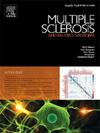Effectiveness and safety of glucocorticoids bridging rituximab in neuromyelitis spectrum disorder
IF 2.9
3区 医学
Q2 CLINICAL NEUROLOGY
引用次数: 0
Abstract
Background
Anti-CD20 monoclonal antibody rituximab have been widely used to prevent relapses in patients with neuromyelitis optica spectrum disorder (NMOSD), but data on early use of oral prednisone overlapping with rituximab for effective reduction of relapses are limited. In this study, we evaluated the long-term efficacy of oral prednisone bridging rituximab therapy in NMOSD patients with anti-aquaporin-4 antibody (AQP4-IgG).
Methods
We collected the medications and disease activities in patients with AQP4-IgG+ NMOSD patients in this retrospective study. Time to first relapse was evaluated after starting stable doses of prednisone and/or initiating rituximab. We compared the efficacy and safety of different doses of prednisone with sequential rituximab treatment in NMOSD.
Results
211 patients fulfilled the inclusion criteria for the study, including 91 patients who were treated with prednisone monotherapy and 120 patients who were treated with prednisone bridging rituximab. In total, 59.3% (54/91) of patients in the prednisone monotherapy group experienced new relapses. The proportions of patients with relapses were different in the subgroups of prednisone monotherapy, with 100% (23/23) in the group of dose ≤ 5mg/d, 64.1% (25/39) in the group of doses 7.5–10mg/d, and 20.7% (6/29) in the group of dose ≥ 12.5mg/d. 24.2% (29/120) of patients in the prednisone bridging rituximab group experienced relapses. Bridging rituximab regimen significantly reduced the risk of relapses compared to prednisone monotherapy (hazard ratio: 0.24, 95% CI: 0.15–0.38, p < 0.0001). Patients with prolonged usage of prednisone tapering (6–12 months) had a significant reduction in the relapse risk compared to those with prednisone tapering 3–6 months (hazard ratio: 0.3119, 95% CI: 0.09125–1.066, p = 0.0264). The most common adverse events were hyperlipidemia in the prednisone monotherapy group (17.6%) and infections in the prednisone bridging rituximab group (25.8%).
Conclusions
Prednisone bridging rituximab therapy is associated with the reduced relapse risk in patients with AQP4-IgG+ NMOSD, especially when the bridging time is over 6 months.
求助全文
约1分钟内获得全文
求助全文
来源期刊

Multiple sclerosis and related disorders
CLINICAL NEUROLOGY-
CiteScore
5.80
自引率
20.00%
发文量
814
审稿时长
66 days
期刊介绍:
Multiple Sclerosis is an area of ever expanding research and escalating publications. Multiple Sclerosis and Related Disorders is a wide ranging international journal supported by key researchers from all neuroscience domains that focus on MS and associated disease of the central nervous system. The primary aim of this new journal is the rapid publication of high quality original research in the field. Important secondary aims will be timely updates and editorials on important scientific and clinical care advances, controversies in the field, and invited opinion articles from current thought leaders on topical issues. One section of the journal will focus on teaching, written to enhance the practice of community and academic neurologists involved in the care of MS patients. Summaries of key articles written for a lay audience will be provided as an on-line resource.
A team of four chief editors is supported by leading section editors who will commission and appraise original and review articles concerning: clinical neurology, neuroimaging, neuropathology, neuroepidemiology, therapeutics, genetics / transcriptomics, experimental models, neuroimmunology, biomarkers, neuropsychology, neurorehabilitation, measurement scales, teaching, neuroethics and lay communication.
 求助内容:
求助内容: 应助结果提醒方式:
应助结果提醒方式:


